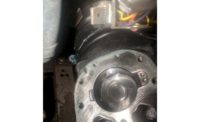
A contractor has the option of installing one of three loop configurations - horizontal, vertical, and pond loops.
As homeowners and building owners explore ways to increase the efficiency of their heating and cooling systems and reduce energy costs, many are taking a closer look at the benefits that geothermal technology offers. In the process, they are unearthing the truth about geothermal systems and dispelling many of the commonly held misconceptions that surround the technology, including the 10 that follow:
1. Geothermal technology is a new technology that doesn’t have a proven track record.In fact, geothermal technology has been used successfully to heat and cool homes and buildings for several decades. Also referred to as geoexchange, ground-water, ground-water assisted, and ground-source systems, the technology today provides heating and cooling to more than 1 million residential, commercial, and government buildings in the United States. And each year U.S. homeowners install approximately 50,000 more geothermal heat pumps.
2. Geothermal technology is a difficult technology to understand and master.The three main components of a geothermal system are a ground-source heat pump, a loop, and an air delivery system (ductwork). The ground-source heat pump is not unlike the air-source heat pump in a conventional heating and cooling system. The same components are at work - a compressor, condenser, and evaporator coil - and the results are similar: both systems move heat rather than create heat to ensure a comfortable living space. The difference is, a geothermal system relies on the ground rather than the air to either absorb or dissipate heat energy.
To gain a thorough understanding of geothermal technology, it is a good idea for contractors to align themselves with a manufacturer they know and trust - one that can provide a quality product and the equipment, sales, and installation training that are so important to a contractor’s success. WaterFurnace, for example, offers contractors a three-day service and installation training program that is certified by the International Ground Source Heat Pump Association (IGSHPA).
3. Sizing a geothermal system requires special training.As is the case with a conventional heating and cooling system, a geothermal system must be properly sized to gain the efficiencies of the system. Oversized equipment will cycle on and off more frequently, reducing the efficiency of the system and delivering marginalized comfort. On the other hand, undersized equipment will run longer than necessary because the equipment is not large enough to deliver the desired amount of conditioned air. The result is the same - compromised efficiency and comfort.
The sizing process for a geothermal system is no different than it is for a conventional system. Most contractors rely on the Air Conditioning Contractors of America’s (ACCA) Manual J Residential Load Calculation to determine the heat gain/loss calculation. Using software or manual solutions based on Manual J, contractors consider and record data that impacts the heat gain/loss of a structure, including insulation values; the number, placement, and types of windows and doors; weather stripping; primary building materials; exposure to sunlight; the number, placement, and types of trees around the structure; overhangs; wind shielding; number of fireplaces and flues; attic accesses; number of occupants; equipment in the structure that generates heat, including appliances, computers, lighting, and media systems; roof and siding color; and the size of the actual living space.
4. Contractors interested in offering geothermal systems must be able to install the loop, making installation of a geothermal system more complicated than a conventional heating and air-conditioning system.Although loop training is available through manufacturers or IGSHPA, many contractors choose to subcontract this portion of the installation process. When you add the fact that a geothermal system means contractors do not have to run gas lines, a chimney or flue pipe or refrigerant lines, installing a geothermal system can actually be easier than installing a more conventional system.
5. The efficiency of a geothermal system is limited to geographic areas where temperatures are moderate. Geothermal systems are installed in homes from the cold climate of northern Canada and Alaska to the heat of Florida and Texas. Various sizes, configurations, and options enable a system to be installed in virtually any application, regardless of the location.
6. Older homes cannot be retrofitted with a new geothermal system. Geothermal systems are great for retrofit applications.A contractor can easily install most units, particularly when they replace another forced-air system. Ductwork must be installed in homes that do not have an existing air distribution system. Geothermal systems can be installed in areas unsuitable for fossil fuel furnaces, because there is no combustion and therefore no need to vent exhaust gases.
7. A homeowner needs a large lot to install a geothermal system.A homeowner need not have a large lot to install a geothermal system because the contractor has the option of installing one of three loop configurations - horizontal, vertical, and pond loops. A horizontal loop requires the most space - typically 1/4 to 3/4 acre for the trenches - and a contractor will use this style loop with new construction or if the homeowner has a large lot. Pipes are placed 4 to 6 feet below the surface in trenches that range in length from 100 to 400 feet.
However, a large lot is not necessary. A vertical loop is the ideal choice where space is limited, although it generally costs more than horizontal or pond loops. In fact, three to five vertical loops can be installed in an area no bigger than 10 feet by 20 feet. Drilling equipment is used to bore small-diameter holes from 75 to 300 feet.
A pond or lake loop is very economical to install when a large body of water is available. A 1/2-acre, 8-foot-deep pond is usually sufficient for the average home. Ideally, the pond should be close to the home (less than 200 feet). Coils of pipe are simply placed on the bottom of the pond or lake. Pond loops are a cost-effective way to install a geothermal system because trenching is limited to only the supply and return piping from the pond to the house.
8. Homes heated and cooled with a geothermal system are not as comfortable as those conditioned by a conventional heating and cooling system. Geothermal systems provide precise distribution of comfortable air all year long, eliminating hot and cold spots. During heating, homeowners experience consistent warm air, and, additionally, when cooling, geothermal units deliver cool, dehumidified air, and they can provide up to 100 percent free domestic hot water.
Comfort also includes quiet. Unlike conventional systems, a geothermal system does not use an outdoor unit that disturbs the quality of the outdoor environment. WaterFurnace designs and constructs its geothermal units for quiet operation, with some models featuring variable-speed fan motors and acoustical enclosures for the compressors.
9. Geothermal systems require complicated maintenance programs to maintain their efficiency.The maintenance costs associated with a geothermal system are minimal. The components are located inside where they are not subject to the wear and tear caused by rain, snow, ice, debris, extreme temperatures, and vandalism.
All that is necessary in terms of maintenance is the regular cleaning of the air filter and the occasional cleaning of the indoor drain pan. Most of the piping is underground or underwater and requires no maintenance.
Geothermal systems also offer homeowners increased longevity and peace of mind. Although a conventional heat pump or gas furnace might have an average life span of 10 to 15 years, a geothermal unit lasts on average 24 years, and the ground loop could last a lifetime.
10. The upfront cost of a geothermal system makes it difficult to sell the system. In most cases, the cost to install a geothermal system will exceed that of a conventional system. However, any added investment over the cost of the most efficient conventional system is generally recovered in energy savings within a few years. That’s because the efficiency rating of a geothermal system is up to five times higher than that of a conventional heating and cooling system. WaterFurnace manufactures the Envision™ line that achieves 500 percent efficiency in heating and a 30 Energy Efficiency Ratio (EER) in cooling. These efficiency ratings allow system owners to save as much as 70 percent on their energy bills, compared to ordinary systems.
As a result, for new homes, the upfront cost of a new geothermal installation can be included in monthly mortgage payments. The increase in the mortgage payment is typically offset by the decreased operating costs of the system, providing a positive cash flow from day one and an immediate payback. In the replacement market, many geothermal systems deliver monthly energy savings that surpass payments associated with the installation of the new system.
In addition to impressive energy savings, tax incentives, manufacturer rebates, and utility programs are making it easier to sell geothermal. The American Recovery and Reinvestment Act of 2009 offers homeowners a one-time renewable energy tax credit of 30 percent of the total investment for residential geothermal heat pump installations through Dec. 31, 2016. A credit of 10 percent of the total investment is also available for a commercial system installation.
These incentives, when combined with other state tax credits and utility rebates, make geothermal systems more accessible to homeowners and increase sales opportunities for the contractors who sell and install them, especially when contractors identify the tax credits as the latest addition to a long list of benefits that make geothermal technology an attractive alternative to fossil fuel heating and cooling systems.
For more information, go to www.waterfurnace.com.
Publication date:07/26/2010





